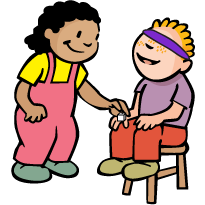Boston Children's Museum
308 Congress Street, Boston, MA 02210
617-426-6500
© Boston Children’s Museum 2025
Website Design by JackrabbitChildren’s bodies are undergoing constant change. By getting to know their own bodies better, these changes can be less mysterious. Children who are in tune with their own bodies can use all of their senses as tools as they explore and try to understand the world around them. This activity helps children learn more about their sense of touch.
At least 1 day ahead of time, fill enough ice cube trays with water so there are at least 2 ice cubes per pair of students. Stretch a piece of plastic wrap across the ice cube trays and poke a toothpick into each cube compartment. Place the trays in a freezer. When they are frozen, the cubes will have little “handles” made by the toothpicks, which will make it easier for kids to hold the ice cubes for longer periods of time.

Ask your students what sorts of things their skin can sense. Make a list on a piece of chart paper or a blackboard. Highlight touch, hot, cold, pain and pressure (if any of those are missing, try to lead them to it by asking questions about different sensations they’ve felt. Example: If “hot” is missing, ask them what it feels like to touch something that has been sitting in the sun for a long time). Tell your students that they’ll be testing their skin for how well it can feel some of these sensations.
Can you test what parts of your skin sense cold best? How about the parts that sense pain best?
After every child has tested their skin, stop your students and bring them together to share their observations with each other. Did anything surprise them? What parts of their bodies felt the cold best? What parts felt it the least? This discussion should last no more than a few minutes.
Ask your students to now test their pain sensors. Repeat the experiment used to test cold, but this time have one child touch the ice cube to their partner’s skin and hold the cube there. The Tester should either use a stopwatch or count out loud (1 alligator…2 alligator…etc.) until the Senser says that the ice cube feels uncomfortable on his or her skin. Have them record on paper the part of the body tested and how long it took until the cold felt uncomfortable. Try different parts of the body and then switch roles.